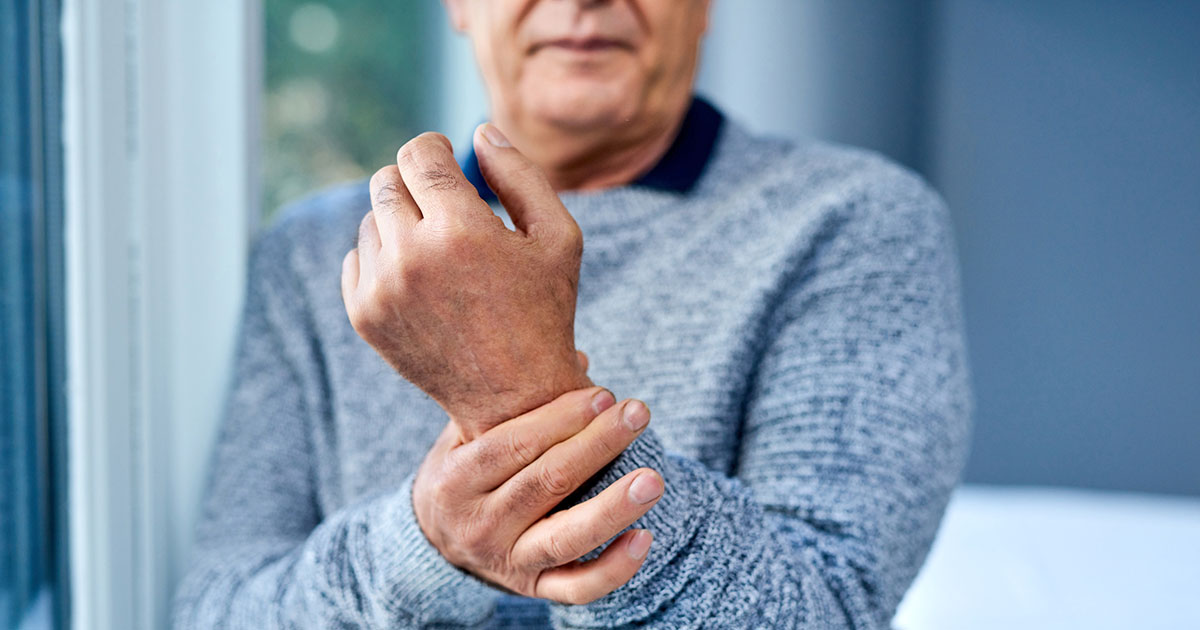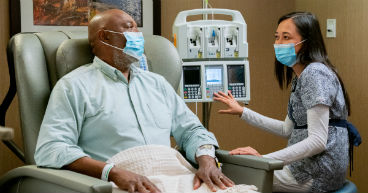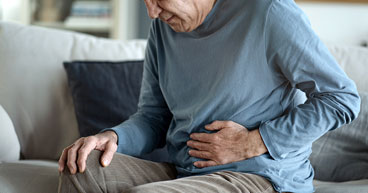
Nausea, vomiting and other digestive issues are common side effects of cancer and certain cancer treatments. The National Institutes of Health estimate that up to 70 percent of cancer patients experience nausea and vomiting.
These symptoms need to be controlled since prolonged nausea and vomiting may cause dehydration or make it difficult to get proper nutrition to keep patients’ body strong beyond affecting their general quality of life and mental health.
While anti-nausea medications are widely used to treat these symptoms, other complementary therapies such as acupressure have been shown to be an effective addition to medication and, in some cases, can even reduce the need for drugs.
An experienced therapist can use acupressure to treat nausea and vomiting, or, with training and practice, patients may be able to self-administer the therapy as needed, making it a convenient and cost-effective alternative.
Acupressure “is a very safe, effective technique to use,” says Adam Kerievsky, ND, LAc, FABNO a naturopathic provider at City of Hope® Cancer Center Phoenix, who treats patients with acupuncture and acupressure. “Even if it helps mildly it’s something that I think can be introduced and utilized with all patients who are going through a treatment that causes nausea and, theoretically, they can do it very cheaply.
“As an integrative approach, [acupressure also involves] taking their nausea medication as prescribed,” Kerievsky says, “I have seen patients where they’ve needed less medicine [when using acupressure].”
In this article, we’ll explore:
- What is acupressure?
- Acupressure and nausea: What the research says
- Pressure points for nausea and vomiting
- How long to apply acupressure
- When to avoid acupressure
- Other supportive therapies for cancer patients
If you’ve been diagnosed with cancer and are interested in a second opinion on your diagnosis and treatment plan, call us or chat online with a member of our team.
What is acupressure?
Acupressure has been used since ancient times when healers first identified points on the body, where, if pressure is applied, physical pain, fatigue or other symptoms like nausea and vomiting may be relieved.
These points also may be stimulated with fine, wire-like needles as in the traditional Chinese practice of acupuncture. Acupuncture and acupressure use the same points on the body to help patients with a wide array of ailments.
Modern western medicine has investigated how these ancient treatments may work and found that applying pressure to or putting an acupuncture needle into certain nerve fibers may release chemicals in the body such as endorphins, which alleviate pain, Kerievsky says. Stimulating nerves may also trick the brain into “forgetting” pain or other symptoms like nausea.
Acupressure also has been shown to enhance blood circulation, help release muscle tension and promote relaxation, all of which may help relieve symptoms.
“There’s good clinical evidence for acupuncture and acupressure,” Kerievsky says, adding that studies have shown its effectiveness in treating nausea during chemotherapy, pregnancy, postoperatively and for those who have had a heart attack.
“I’ve definitely seen it help patients,” Kerievsky says. “And it’s not just for nausea, it may help with pain as well.”
Acupressure and nausea: What the research says
Multiple scientific studies over the years have linked acupressure to relief of nausea and vomiting in cancer patients.
Findings from a clinical trial published in March 2022 in BMC Complementary Medicine and Therapies concluded that auricular acupressure, stimulating acupoints in the ear, along with anti-nausea medication, was more effective in reducing nausea and vomiting than the medication alone in breast cancer patients undergoing chemotherapy.
A 2007 study published in the journal Oncology Nursing Forum involving 160 women undergoing chemotherapy for breast cancer found that applying acupressure to the point just above the wrist on the inside of the arm, also known as the pericardium 6 (P6) point, offered significant reduction in the intensity of the women’s nausea and reduced the amount of vomiting compared to those receiving the usual anti-nausea, anti-emetic medications.
The researchers concluded that “acupressure at the P6 point is a value-added technique in addition to pharmaceutical management for women undergoing treatment for breast cancer to reduce the amount and intensity of delayed CINV.”
Yet another study published in 2016 found that among 44 young cancer patients, aged 5 to 18 years, manual acupressure and wearing a wristband that applies pressure to the P6 acupoint reduced the amount of nausea and vomiting. Manual acupressure was found to be more effective than wearing the wristband, however, when compared to those not receiving either type of therapy.
Pressure points for nausea and vomiting
With guidance and practice, patients can learn where particular points are on the body, how to apply the proper amount of pressure and how to move their fingers in a circular motion to stimulate the acupoint to relieve symptoms like nausea and vomiting.
Still, finding the right point may require some expert advice. Kerievsky remembers as an acupuncture student having to identify acupoints using the small adhesive circles used to reinforce three-ring binder papers.
“You’d have to hit the point on the inside of the ring,” he says, noting that for someone self-administering acupressure, some points may be more challenging than others to find accurately.
“It can get a little challenging to accurately hit the bullseye…if you’re off the point [the treatment] may not work as well,” Kerievsky says, adding that the P6 point is relatively easy to find and to apply pressure to. The ultimate test of whether patients have found the proper point is if they experience relief, he says.
Keep in mind as well that patients don’t actually have to be experiencing the symptom at the moment they perform the acupressure.
“There’s no harm to doing [acupressure] preventatively,” Kerievsky says. “Taking your [nausea] medicine would also be a good idea [if you know you’re going to experience nausea.]
With any acupressure therapy, Kerievsky advises find a relaxing place to sit or lie down comfortably. Take several deep breaths before beginning. Breathing should be natural and relaxed throughout the session. Use the thumb or fingers to apply pressure.
The amount of pressure varies depending on the acupoint. Points around larger muscles may require more pressure. Lighter pressure should be applied if patients experience any pain or tenderness. Once patients find the proper point, they should firmly press and massage it using small circular motions—either clockwise or counterclockwise.
Several acupoints have been identified to help relieve nausea and vomiting, including those near the wrist, knee and feet. To get relief it is not necessary to perform acupressure on every acupoint. Some points may be more effective than others and patients may want to focus on those. Patients should talk to their provider about how to find these pressure points.
How long to apply acupressure
Acupressure may be used as often as necessary each day or periodically throughout the week or month.
Once the proper point is found, pressure and massage may be applied anywhere from 30 seconds to continuously. The time and frequency depend on each patient’s unique circumstances and what brings relief. Some experimentation may be necessary to determine the proper length of time.
Wristbands with balls as well as various electronic devices are on the market that can easily be worn on the P6 point to apply pressure or stimulation for prolonged periods to treat chronic nausea and vomiting.
“For some patients [nausea] is a chronic, all-day symptom and a device might be most effective,” Kerievsky says. “But if you don’t put that wrist device on the right place you may not be getting the most benefit.”
When to avoid acupressure
Generally, acupressure is safe as a therapy, but if the skin near a pressure point is infected, peeling or blistering, or if it is red, warm or swollen, do not put pressure on the area. Likewise, if there is a varicose vein, wound or tumor present, do not use acupressure at that spot. If one side of the body is swollen due to lymphedema or other causes, that area should be avoided.
“Theoretically if you press on a point too hard for too long you could get a bruise,” Kerievsky says, adding that those on blood thinners should check with their health care team before trying acupressure. Pregnant women or those with blood pressure issues, should also consult with a health care professional before attempting acupressure.
“It’s very rare to have a negative outcome,” Kerievsky says. “I’ve never actually seen something negative, but it can happen theoretically.”
Patients should speak with their health care team about all options for managing nausea and vomiting, especially if they are unable to keep fluids down or have been vomiting regularly for 24 hours or longer.
Beyond nausea and vomiting, research shows that acupressure may relieve other cancer-related symptoms and side effects, including fatigue, and pain.
For instance a 2018 study in JNCI Cancer Spectrum found that pain, fatigue, depression and anxiety were lessened when breast cancer patients self-administered acupressure compared to those who received the usual treatments.
Other supportive therapies for cancer patients
Each patient’s circumstances are unique and consulting with the care team can help everyone access the specific therapies that will help enhance his or her quality of life.
Other supportive care therapies to help with cancer symptoms and generally improve quality of life include:
- Massage
- Behavioral health counseling
- Exercise or physical therapy
- Nutritional support
- Spiritual support
It may be a good idea to talk to a care team member about the potential benefits of supportive care services to help you assess what may be right for your individual needs.
If you’ve been diagnosed with cancer and are interested in a second opinion on your diagnosis and treatment plan, call us or chat online with a member of our team.


